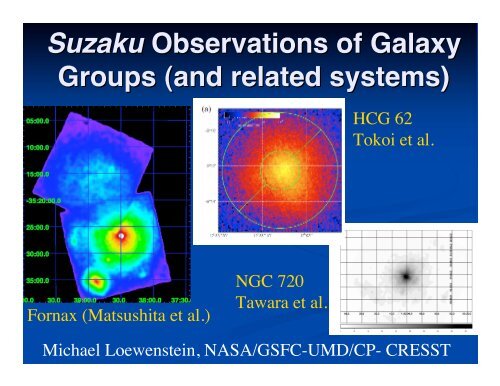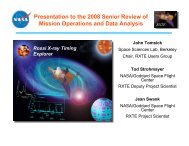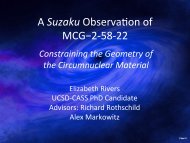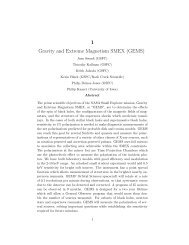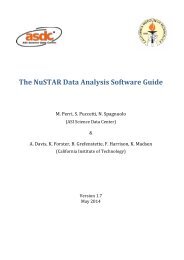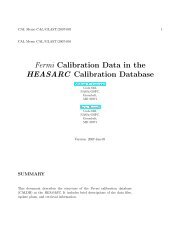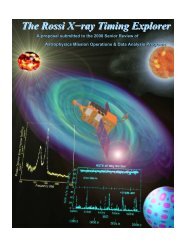Suzaku Observations of Galaxy Groups (and related systems)
Suzaku Observations of Galaxy Groups (and related systems)
Suzaku Observations of Galaxy Groups (and related systems)
Create successful ePaper yourself
Turn your PDF publications into a flip-book with our unique Google optimized e-Paper software.
<strong>Suzaku</strong> <strong>Observations</strong> <strong>of</strong> <strong>Galaxy</strong><br />
<strong>Groups</strong> (<strong>and</strong> <strong>related</strong> <strong>systems</strong>)<br />
HCG 62<br />
Tokoi et al.<br />
Fornax (Matsushita et al.)<br />
NGC 720<br />
Tawara et al.<br />
Michael Loewenstein, NASA/GSFC-UMD/CP- CRESST
Outline<br />
• Setting the stage: <strong>Groups</strong>, X-rays, <strong>and</strong> <strong>Suzaku</strong><br />
• Early <strong>Suzaku</strong> results -- temperature structure,<br />
abundance gradients <strong>and</strong> patterns<br />
• Promise <strong>and</strong> Priorities
Matter in the Universe<br />
(the modern view)<br />
• Most <strong>of</strong> the matter in the universe is dark matter,<br />
collapsed into a hierarchy (10 7 -10 15 M ) <strong>of</strong> halos<br />
• Galaxies are embedded in halos (that may be<br />
embedded in larger halos…)<br />
• Larger halos have more galaxies that move faster<br />
σ<br />
M<br />
richness<br />
Becker et al. 2007
What is a <strong>Galaxy</strong> Group?<br />
(a personal definition)<br />
• A dark matter halo with >2 galaxies <strong>and</strong> σ gal ~ σ stars<br />
(σ~150-400 km/sec), i.e. ~ M~ 10 13 - 10 14 M <br />
• Optical: 3-50 galaxies, d~Mpc, L~ 10 11 - 10 12 L <br />
• X-rays: kT
Sub-types <strong>of</strong> interest<br />
X-ray:<br />
NASA/CXC/INAF-<br />
Brera/G.Trinchieri et<br />
al.;<br />
• Compact (HCG) -- short dynamical time<br />
• Fossil -- light dominated by single elliptical<br />
(complete merging, early formation )<br />
• Cluster subgroup (e.g., NGC 4472)<br />
NASA/CfA/J. Vrtilek et al.<br />
Scale<br />
Khosroshahi et al. 2007
Why Study <strong>Groups</strong>?<br />
• <strong>Groups</strong> are where most galaxies live, <strong>and</strong> are<br />
the building blocks <strong>of</strong> LSS<br />
• A laboratory for galaxy mergers, <strong>and</strong> mergerinduced<br />
activity <strong>and</strong> feedback (σ gal ~ σ stars )<br />
• An incubator for ellipticals: “The centers <strong>of</strong><br />
massive groups are the preferred environment<br />
for the merger-driven assembly <strong>of</strong> massive<br />
ellipticals” (McIntosh et al. 2007)
Why Study <strong>Groups</strong> in X-rays?<br />
• Theyʼre cool: signature <strong>of</strong> non-thermal emission<br />
<strong>and</strong> feedback more apparent<br />
• The total mass, assembly history, <strong>and</strong> SFH are<br />
reflected in IGM thermal, morphological, <strong>and</strong><br />
chemical properties <strong>and</strong> IGM scaling relations<br />
• Compare chemical <strong>and</strong> thermal properties with<br />
clusters: are the cluster abundance anomalies<br />
anomalous; are cluster building blocks like<br />
present-day groups; are clusters really<br />
representative?
ROSAT <strong>and</strong> ASCA Highlights<br />
• Extended ~keV X-ray emission is common, <strong>and</strong><br />
ubiquitous in massive/elliptical-dominated groups<br />
• (Most) HCGs are bound<br />
• <strong>Groups</strong> are dark matter dominated<br />
• <strong>Groups</strong> deviate from cluster scaling relations, <strong>and</strong><br />
show an excess core entropy<br />
• Discovery <strong>of</strong> fossil groups
ROSAT <strong>and</strong> ASCA Highlights<br />
• Abundances <strong>of</strong> Fe <strong>and</strong> Si<br />
Davis et al. 1999<br />
Hwang et al. 1999<br />
Ponman et al. 2003
XMM-Newton <strong>and</strong> Ch<strong>and</strong>ra<br />
• Detailed pr<strong>of</strong>iles, maps <strong>of</strong> abundance, entropy…<br />
(e.g., Finoguenov et al.)<br />
NGC 5044 abundances<br />
NGC 3923 entropy
XMM-Newton <strong>and</strong> Ch<strong>and</strong>ra<br />
More heating evidence, less clarity on how <strong>and</strong> when<br />
Finogueonov et al.
XMM-Newton <strong>and</strong> Ch<strong>and</strong>ra<br />
• To higher redshift, more detail, <strong>and</strong> larger radius<br />
GEMS --Ch<strong>and</strong>ra (Rasmussen <strong>and</strong> Ponman 2007)<br />
scaled temperature<br />
Si/Fe (grsa)<br />
r/r 500
XMM-Newton <strong>and</strong> Ch<strong>and</strong>ra<br />
• High resolution spectra, multi-phase models<br />
NGC 5044<br />
Si/Fe pr<strong>of</strong>ile<br />
Tamura et al. 2003 Buote et al. 2003
Why Study <strong>Groups</strong> with <strong>Suzaku</strong>?<br />
Lower background plus better (CCD) spectral resolution<br />
• push to the virial radius<br />
• more emission lines<br />
-- correct spectral model (multi-temperature <strong>and</strong> optical<br />
depth signatures)<br />
-- more accurate abundances <strong>and</strong> abundance gradients<br />
<strong>of</strong> more elements<br />
• good synergy with Ch<strong>and</strong>ra ACIS, XMM MOS/pn (better<br />
imaging) <strong>and</strong> RGS (better spectral resolution)<br />
• signature <strong>of</strong> non-thermal emission in HXD (Fukazawa)
Cool (
Case Study: HCG 62<br />
See Tokoi-san’s poster (A23) <strong>and</strong> preprint (0711.1454)
Temperature Structure<br />
XIS requires 2-T model in NGC 1399, HCG 62, NGC 4472<br />
Matsushita et al. 2007<br />
Fukazawa et al. 2006 (Ch<strong>and</strong>ra)<br />
multi-phase or gradient? implications for heating <strong>and</strong> mass<br />
pr<strong>of</strong>ile? implications for abundances? same for NGC 4472
Temperature Structure in HCG 62<br />
<strong>Suzaku</strong> (Tokoi et al. 2007)<br />
(1’~18 kpc, r virial ~1˚)<br />
Ch<strong>and</strong>ra/XMM<br />
(Morita et al.<br />
2006)
Abundances<br />
RGS: N(?), O, Ne, Mg, Fe<br />
EPIC/Ch<strong>and</strong>ra: O(?), Ne(?), Mg(?), Si, S(?), Fe<br />
XIS: O, Ne (?), Mg, Si, S, Ar, Fe<br />
NGC 4636<br />
XIS: Hayashi et al. 2008 RGS: Xu et al. 2002
Ch<strong>and</strong>ra (Humphrey <strong>and</strong> Buote 2006)<br />
NGC 4472<br />
Mg XII, Si XIII, SiXIV,<br />
SXV, SXVI, Ar XVII
Complementarity, , e.g. NGC 4472
Abundance Pr<strong>of</strong>iles<br />
Matsushita et al., Tokoi et al.
Abundance Pr<strong>of</strong>iles<br />
courtesy K. Matsushita
Abundance Pr<strong>of</strong>iles<br />
courtesy K. Sato
Abundance Patterns<br />
Similar pattern within<br />
<strong>systems</strong>, <strong>and</strong> from system<br />
to system -- Fe/α≥1<br />
Matsushita et al. 2007<br />
courtesy Y. Fukazawa
Abundance Patterns
Abundances in <strong>Groups</strong> with<br />
<strong>Suzaku</strong>: : Promise<br />
Abundances in IGM are diagnostics <strong>of</strong> heavy element<br />
synthesis (SFH, SNIa) <strong>and</strong> transport (galactic winds,<br />
feedback) -- fundamental galaxy formation processes<br />
<strong>Groups</strong> are important because (compared to clusters)<br />
they are typical, <strong>and</strong> their low kT provides access to<br />
more elements -- we need to underst<strong>and</strong> groups in order<br />
to underst<strong>and</strong> clusters<br />
Early <strong>Suzaku</strong> results demonstrate that a wide range <strong>of</strong><br />
elements -- <strong>and</strong> their distribution -- can be measured to a<br />
new level <strong>of</strong> accuracy, precision, <strong>and</strong> detail
Abundances in <strong>Groups</strong> with<br />
<strong>Suzaku</strong>: : Priorities<br />
More observations <strong>of</strong> a wide range <strong>of</strong> groups!<br />
Do with SCI (resolution matters)<br />
-- need good background tools to go to r virial<br />
Find groups where we can measure Ne (?) <strong>and</strong> Ca (?)<br />
Combine with higher angular resolution observations
Abundances in <strong>Groups</strong> with<br />
<strong>Suzaku</strong>: : Priorities<br />
Connect to cosmological context<br />
SDSS statistical M/L vs. <strong>Suzaku</strong> individual,<br />
star formation/halo connection -- an X-ray analog?<br />
Go to higher redshift (see Miller et al. Poster A22)<br />
Balestra et al. 2007 clusters


